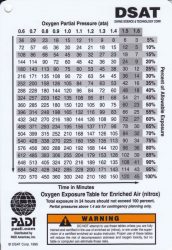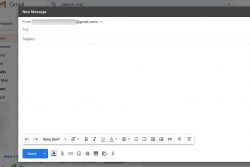Divetalking » Adv. Open Water, Article, Dive Planner, Divetalking, Education, Enriched Air, Featured, NItrox, RDP, Recreational Dive Planner, Reference, Report, Specialties, Training » Understanding Enriched Air Nitrox
Understanding Enriched Air Nitrox
September 3rd, 2020 | Comments Off on Understanding Enriched Air Nitrox
WHAT? More? Remember it was mentioned earlier in addition to keeping track of your Nitrogen load, which is what you just performed switching between the EAD table and your Air RDP you must also keep track of your Oxygen load.
Let’s walk through that now. You would normally keep track of both your Nitrogen and Oxygen at the same time. The two have separate to focus on one aspect at a time.
Turn your EAD Table over to find the Oxygen Exposure Table

Go back to the first dive to 100fsw where your bottom time was 15 minutes.
Question: How much Oxygen Toxicity or CNS load have you incurred?
For this table you will need the PPO for the depth of the dive and the time spent on the dive.
Going back to the Equivalent Air Depth table, you look up the PPO for the depth of the dive.
For a dive to 100fsw on EAN32, your PPO is 1.9. Moving back to the Oxygen Exposure Table the row across the top is PPO. You do not find a 1.29 but you do find a 1.3. Now scan down the column below 1.3. You first see a 9, then an 18. 15 minutes falls between 9 and 18 so you use the 18 minutes. NOTE: You always round UP.
To the far right is 18 you see a percentage. That percentage should read 10%. That is your Oxygen Toxicity Load for this dive.
For a 15 minute dive to 100fsw on EAN32 your Oxygen Toxicity load is 10%.
Do the same for the second dive to 80fsw. That second dive was for 20 minutes. The PPO at 80fsw on EAN 32 is 1.10
Looking at the OET for 1.10 on the top row, scan down until you find 20 minutes or the next highest number. You should have found 24 minutes and to the far right an Oxygen load of 10%..
You body Oxygen load for the first dive was 10%, your second dive was 10% for a total of 20% (10% + 10%).. The total load is the sum of all your dives for the day. It is accumulative and you do not earn any credit for your surface interval.
So far you are up to 20%…
The third dive was to 60fsw on EAN32 for 45 minutes
Ansswer the following questions by performing the steps on your own.
Question: What is your Percent Oxygen Exposure for that dive?
Answer: 15%
Question: What is your total Oxygen Exposure at this point?
Answer: 35% (10%+10%+15%)
The fourth and final dive was to 40fsw on EAN32 for 60 minutes
Question: What is your Percent Oxygen Exposure for that dive?
Answer: 15%
Question: What is your total Oxygen Exposure at this point?
Answer: 50% (10%+10%+15%+15%)
I hope the article made sense and it proves to be helpful. Should you feel the need to reach out to Larry Davis. you may do so by filling out the contact form below.

Answers to questions Previously Asked
The question: Assuming no decompression obligation, using the new ascent mythologies how long, at a minimum will it take you to break the surface from a depth of 90 feet?
My answer: A minimum of 8 minutes… at 30’/minute
Question: What will the PPO on a 32% mix be at 100fsw?
PPO=(((Depth / 33 ) + 1) * FO) ; PPO=((( 100 / 33 ) + 1) * .32)
Answer: PPO=1.28
Question: What is your NDL for your first of a series of dives to 100fsw on a 32% mix?
Answer: 30 Minutes
Take the Nitrox Quiz. If you took the Nitrox Quiz prior to reading this article, take the quiz again and compare your results. See if your knowledge improved after reading the article
Click HERE to take the quiz
© 2020 – 2021, admin. All rights reserved.
Pages: 1 2 3 4 5 6 7 8 9 10 11 12 13 14 15 16
Filed under: Adv. Open Water, Article, Dive Planner, Divetalking, Education, Enriched Air, Featured, NItrox, RDP, Recreational Dive Planner, Reference, Report, Specialties, Training · Tags: diving on nitrox, EAN, Enriched air, enriched air nitrox, learn about nitrox, Nitrox, Nitrox certification, Understanding nitrox, Viewport, what is enriched air, What is nitrox
Scuba Diving Calculators
** This will affect all calculations
Cloud Tag
Most commented
Recent Articles
- Where is the Hyperbaric Chamber?
- Clicky.com Advanced real-time web analytics
- Divers and crew missing after Red Sea liveaboard Sea Story sinks
- Nekton’s Rorqual and Pilot, former scuba lieaboards to become artificial reefs off Destin-Fort Walton Beach
- Laser Engraving, Marking and Cleaning of High-Pressure Vessels
- Loggerhead Holdings, Inc Joint Law Suit
Tag Cloud
artificial reef blowing up reefs Canon 5D Mark III cay sal conservation cozumel death dive diver dive show divetalking dolphin explosive reefs FIsh ID fishinar Fred Morrow Fred Morrow Artificial Reef Fred Morrow Reef FWC Leatherback lionfish lion fish lionfish derby lionfish harvesting logo lost missing Narcosis Nekton Ocean Photography polution Preservation RDP recall Recreational Dive Planner reef scuba show Sharks Shark Weak titanic tuna Underwater Photography Workshop Zeagle© 2026 Divetalking








